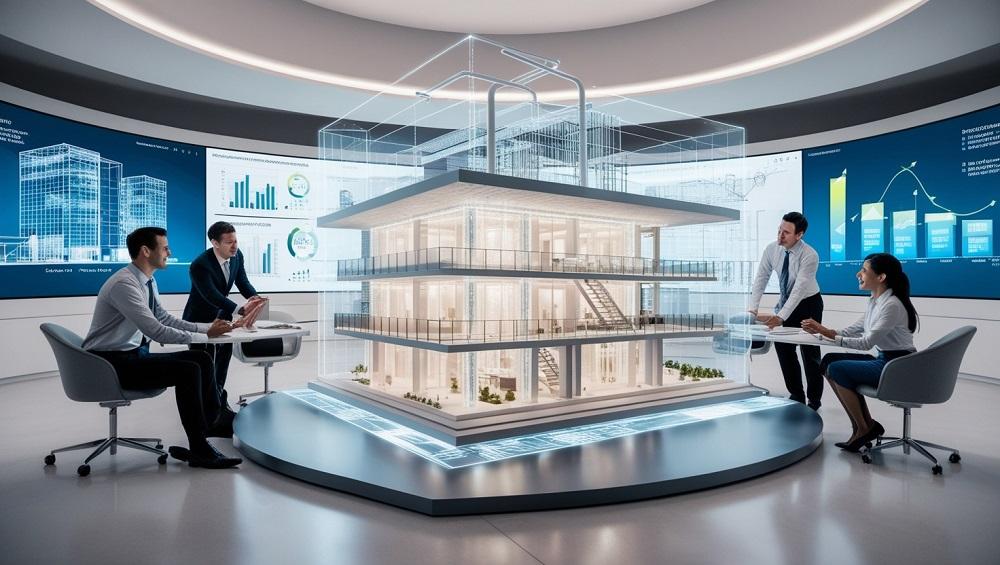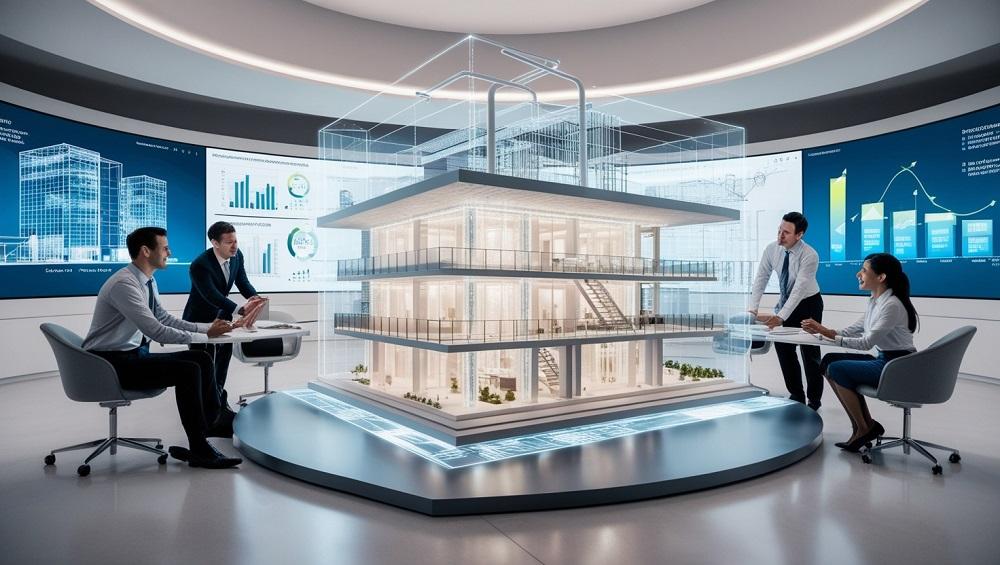How Architectural BIM Modeling Services Improve Design Precision

How Architectural BIM Modeling Services Improve Design Precision

Understanding the Role of Architectural BIM Modeling Services
What sets BIM apart from traditional design tools
Architectural BIM modeling services go well beyond traditional CAD drafting. While CAD focuses on 2D representations and disconnected drawings, BIM integrates data-rich 3D models that represent actual building elements. Walls, doors, windows, and mechanical systems are not just visual—they’re embedded with real-world information, enabling architects and project teams to simulate how each component behaves in the built environment.
Traditional design workflows often rely on manually updating changes across separate drawing sets. This increases the risk of discrepancies. BIM avoids that by updating all views simultaneously, reducing coordination errors and significantly improving the accuracy of construction documentation. These improvements are not cosmetic; they are structural, affecting everything from cost estimation to facility handover.
Key components of architectural BIM workflows
BIM modeling services include more than just 3D geometry. They involve a suite of interconnected tools and standards designed to keep design aligned with practical construction goals. Elements like shared parameters, intelligent object libraries, and predefined templates are foundational to an efficient BIM process.
At the core is the Building Information Model itself—a centralised, federated model that evolves through every phase of the project lifecycle. Project stakeholders, from engineers to quantity surveyors, draw from the same source of truth. This cohesion allows for live updates, minimising information lag and reducing decision-making delays.
Industry applications and client expectations
In architectural practice, BIM is now a baseline expectation, not a luxury. Clients expect architectural teams to use BIM to provide clear visualisations, coordinated documentation, and support during construction. This expectation spans multiple project types, including commercial offices, healthcare facilities, residential towers, and public infrastructure.
Firms delivering architectural BIM modeling services must understand that clients are increasingly savvy. Many have in-house BIM managers or digital leads who evaluate delivery based on model quality, information richness, and compliance with naming conventions or exchange standards. This raises the bar for how thoroughly BIM must be embedded into architectural workflows.
The Impact of BIM on Design Accuracy
Reducing manual errors in documentation
One of the most immediate advantages of using BIM modeling services is the sharp drop in documentation errors. Because all drawing outputs are generated from the model, mistakes caused by outdated or mismatched sheets are largely eliminated. Sections, elevations, and plans all reflect the same geometry. Any design change is reflected across every view in real time.
This automation cuts down on time-consuming cross-checks and ensures that all parties are working from consistent documentation. It also reduces human error in quantity takeoffs, which depend on accurate model data. By automating schedules and tags, architectural teams can deliver more reliable outputs with fewer revisions during construction.
Enhancing dimensional consistency in design
Precise dimensioning is crucial in architecture, especially when tolerances are tight or when prefabricated elements are used. BIM tools make it easier to apply consistent measurement standards throughout a model. Geometry can be locked, aligned, and referenced directly from the model, which avoids the drift or rounding issues often seen in 2D workflows.
Whether it’s ensuring door clearances meet code or verifying corridor widths for accessibility compliance, BIM allows architects to make decisions based on exact dimensions. Consistency also translates into better coordination with engineering disciplines and suppliers, reducing the need for last-minute adjustments.
Clash detection and resolution before construction
Architectural BIM modeling services often integrate clash detection tools to resolve spatial conflicts between disciplines before reaching site. For example, if an HVAC duct cuts through a beam or a plumbing riser intersects a partition wall, BIM can flag it early in design.
These checks are not limited to hard clashes. BIM software also identifies soft or spatial conflicts—such as insufficient clearance around equipment for maintenance. By resolving these issues digitally, project teams reduce the likelihood of costly on-site delays, change orders, or scope creep.
Coordination Between Design and Construction Teams
Real-time collaboration using BIM platforms
Coordination has traditionally relied on emails, RFIs, and marked-up PDFs. BIM platforms change that. Cloud-based tools such as Autodesk BIM 360, Revizto, or Navisworks allow architects, consultants, and contractors to collaborate in real time. These platforms serve as a single point of access for model updates, comments, and issue tracking.
When a design modification is made—say, relocating a stair core—the structural and MEP teams can see the impact immediately. This cuts down on back-and-forth correspondence and ensures alignment before construction begins. It also supports remote teams by providing centralised access regardless of location or time zone.
Aligning architecture with structural and MEP models
One of the defining features of architectural BIM modeling services is the ability to coordinate seamlessly with other trades. Architectural teams must constantly integrate structural and MEP models into the design to detect spatial conflicts and ensure design intent is preserved.
For example, the placement of ceiling-mounted light fixtures must be coordinated with HVAC ductwork and fire suppression systems. Through model federation and clash detection, the architectural model becomes a negotiation space where constraints are identified and resolved collectively. This reduces friction and miscommunication between disciplines.
Facilitating interdisciplinary communication
Technical accuracy alone doesn't guarantee smooth project delivery. Success depends heavily on how clearly information is conveyed across disciplines. BIM enables better communication by offering visual context, embedded data, and issue tracking. Instead of relying on written descriptions, designers can point to elements in the model and attach comments or status markers.
This visual communication bridges gaps between teams with different technical backgrounds. Structural engineers, interior designers, and trade contractors can all reference the same elements, reducing ambiguity. It also empowers clients to make informed decisions by interacting with spatially accurate representations, not just flat drawings.
Improved Project Planning and Lifecycle Integration
Early-stage planning benefits
Architectural BIM modeling services aren’t confined to detailed design. They play a key role in early-stage planning as well. During feasibility studies or concept development, BIM allows architects to test massing, sun exposure, circulation, and basic code compliance using parametric tools.
This early modelling supports informed choices before major commitments are made. Whether selecting structural grids or determining floor-to-area ratios, decisions can be backed by quantifiable data extracted directly from the model. This reduces the chance of major redesigns further down the line.
Integration with scheduling and cost estimation
Another advantage of BIM is its ability to support 4D and 5D workflows—adding time and cost to 3D models. By linking design elements to construction schedules or cost databases, architectural teams can assess buildability and budget impact without waiting for a separate estimating phase.
When used effectively, this integration shortens the preconstruction timeline. Project managers can run simulations to optimise sequencing, identify long-lead items, and prevent out-of-sequence work. BIM becomes not just a design tool but a planning asset for the entire delivery team.
Supporting long-term facilities management
BIM doesn’t stop when construction ends. Models created during design can be handed over for use in facilities management. This includes spatial data, asset tags, product warranties, and maintenance schedules embedded directly into the model.
Owners and operators can use this data to support move-in planning, space utilisation, and future renovations. For example, if a lighting fixture needs replacement, the FM team can click on the element in the model and access the manufacturer’s specifications or service history. This level of detail extends the value of architectural BIM beyond design, making it part of the building’s operational lifecycle.
Technology That Drives Architectural BIM Modeling Services

Leading BIM software in architectural design
BIM modeling services are powered by a suite of software platforms, each serving a specific role in the design process. Autodesk Revit remains a standard for architectural modelling due to its parametric capabilities, integrated documentation tools, and industry-wide adoption. It enables architects to generate plans, sections, and schedules directly from the model, streamlining output and reducing rework.
In more specialised scenarios, software such as Archicad, Rhino with Grasshopper, or SketchUp may be used during early conceptual stages or for visualisation. These tools feed into the BIM ecosystem via imports or conversions, allowing design teams to retain flexibility in their workflows without sacrificing model fidelity.
Use of automation and AI in modelling processes
Automation is becoming increasingly central to architectural BIM modeling services. Through Dynamo, Grasshopper, or Python scripting, repetitive modelling tasks—like placing fixtures, annotating drawings, or populating schedules—can be completed automatically. This frees up time for design review and decision-making.
AI tools are also beginning to influence BIM workflows. From space planning suggestions based on user behaviour to predictive analytics that flag potential cost overruns, these technologies introduce data-driven intelligence into the design process. While still emerging, their adoption is growing across larger practices that manage multiple projects simultaneously.
Cloud-based access and data management
As remote collaboration becomes the norm, cloud-hosted platforms have become indispensable. Centralised models hosted on Autodesk Construction Cloud or Trimble Connect enable simultaneous editing, comment threads, and change tracking. These platforms ensure that everyone is working from the latest model version without relying on emailed files or manual syncing.
Cloud access also strengthens data governance. Permissions can be set by role, ensuring sensitive project data is only accessible to the right people. Automated backups and audit trails provide added security, while real-time insights help teams monitor progress, resolve issues quickly, and track design compliance.
Client Outcomes and Measurable Benefits
Increased speed to design completion
One of the most tangible benefits of architectural BIM modeling services is the acceleration of the design timeline. Because multiple teams can work concurrently within the same model, decisions are made faster, and documentation can proceed in parallel. Design iterations are less disruptive, and updates are easier to manage across sheets and views.
This improved speed doesn’t compromise quality. In fact, it often enhances it. By spending less time on manual tasks and coordination, architectural teams can focus more on design quality and stakeholder engagement. That translates into quicker approvals and faster mobilisation on-site.
Fewer design revisions and change orders
Clash detection, real-time coordination, and embedded data all contribute to a smoother construction process. With fewer on-site surprises, contractors issue fewer RFIs, and architects spend less time reworking details or addressing missed items.
This reduction in change orders is not just theoretical—it has budget implications. Every revision avoided translates into savings on labour, materials, and schedule impacts. For clients, this means greater cost certainty and improved confidence in the design process.
Improved coordination with consultants and trades
Architectural BIM modeling services create a platform for better coordination with engineers, consultants, and trade contractors. Instead of sending static files or waiting for responses to email queries, all parties work from the same federated model. Issues are resolved earlier, and design intent is preserved more faithfully throughout construction.
This proactive coordination reduces the risk of misaligned layouts or conflicting site instructions. It also strengthens working relationships between teams, as communication is faster, more visual, and less prone to misunderstanding. Over time, this improves not just project outcomes but also long-term collaboration between delivery partners.
Choosing a BIM Partner With Proven Expertise
What to look for in a BIM consultant
Not all BIM providers operate at the same level. When choosing a consultant to support architectural BIM modeling services, experience in complex, multidisciplinary projects should be a priority. Look for teams with a strong track record in sectors relevant to the project—whether that’s commercial, healthcare, education, or residential.
Technical expertise is essential, but so is adaptability. A good BIM partner understands that each project has its own constraints and can adjust workflows accordingly. They should be familiar with national and regional standards, offer scalable team support, and be comfortable integrating into both design-led and contractor-led environments.
Communication matters too. Consultants should be able to translate technical model requirements into accessible updates for clients, design teams, and site crews. That clarity can make the difference between a model that lives in the background and one that becomes a live resource for delivery.
Importance of customisable BIM standards
Off-the-shelf templates can only go so far. For architectural BIM modeling services to deliver their full value, standards must be tailored to suit project scope, team structure, and client requirements. This includes naming conventions, model breakdown structures, shared parameters, and file exchange protocols.
Custom standards help ensure consistency across submissions and simplify collaboration between consultants. They also reduce onboarding time for new team members, since expectations are clearly defined from the outset. A BIM partner that can create and maintain these tailored resources brings long-term value to project delivery.
Proper BIM Execution Plans (BxPs), Level of Detail (LOD) matrices, and shared folders are not optional—they’re the backbone of structured BIM. The ability to establish and manage these frameworks shows a consultant’s depth of experience and readiness to support at every project stage.
Case evidence and testimonials
Proven outcomes speak louder than any pitch deck. Look for BIM consultants who can point to actual project outcomes—reduced change orders, successful coordination on complex builds, or shortened construction timelines. Testimonials from architects, general contractors, and developers offer insight into working relationships and delivery reliability.
Consultants who regularly contribute to thought leadership, industry events, or standard-setting bodies often bring added credibility. They’re not just using BIM tools—they’re helping shape how the industry uses them. That kind of engagement reflects a commitment to best practice and continuous improvement, both of which directly benefit project teams.
Final Word
Architectural BIM modeling services offer more than just improved visuals—they enable smarter design, better coordination, and greater accuracy from concept through to facilities management. When delivered by experienced teams, BIM becomes a live asset that drives project efficiency and client satisfaction from day one.






